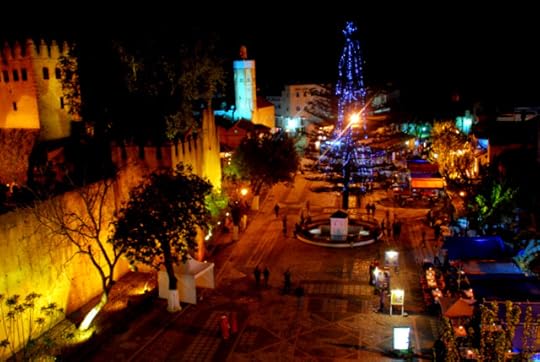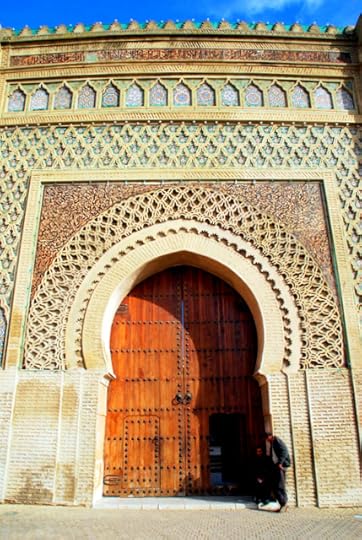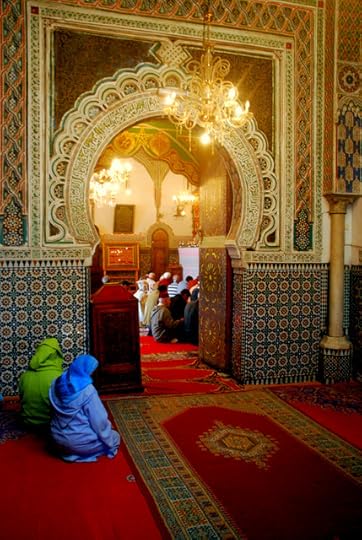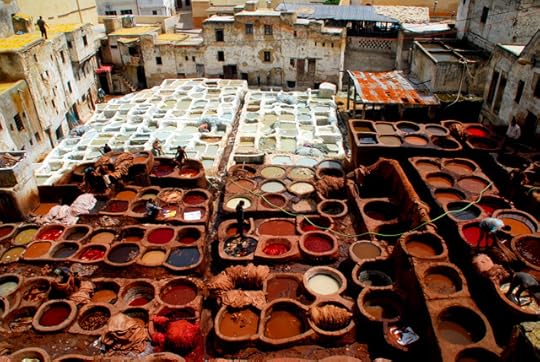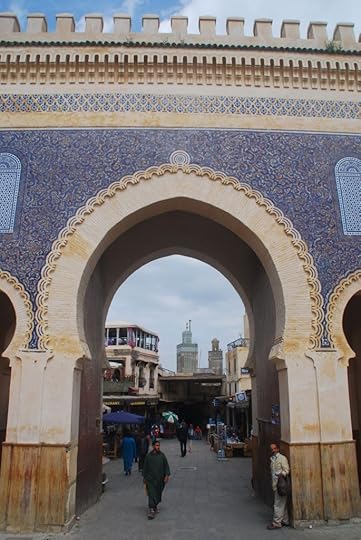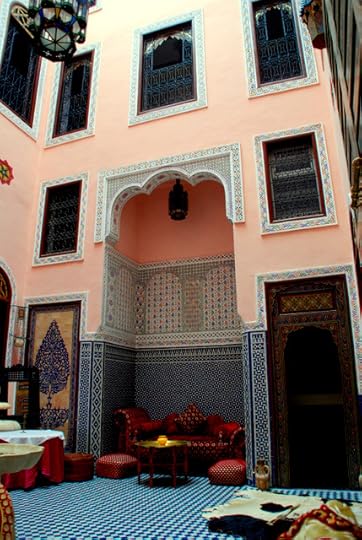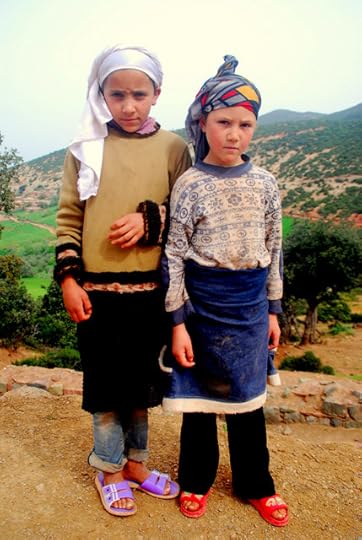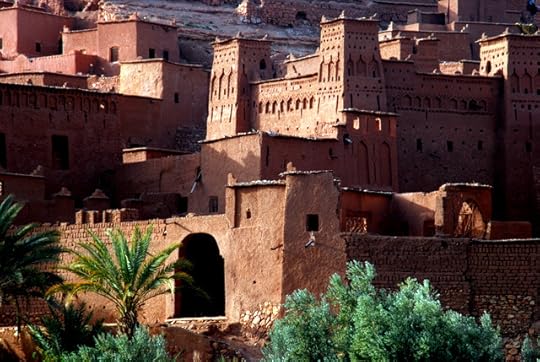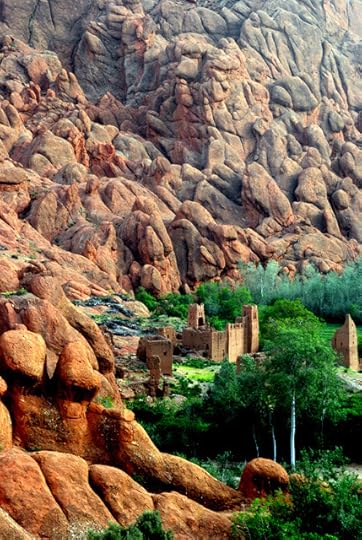Roderick Phillips's Blog, page 11
April 15, 2014
Chefchaouen, Morocco, Day 251
Christi and I leave the riad Khouloud and Fes after 6 nights for the mysterious mountain town of Chefchaouen. Our feelings for Fes are mixed. I thoroughly enjoyed the city and our day trips to Meknes and Volubilis. Christi, perhaps understandably, less so. But she is perking up a little, so there may yet be time for her to embrace Morocco. Our bill for accommodation at the riad Khouloud comes to a whopping 3,000D (about US$375). Saleem, the manager, may not have been too thrilled when we initially negotiated the favorable room rate of 500D per night, but he’s sure smiling now when I hand over the large wad of cash.
Reluctantly, we have returned to the CTM bus service for our ride to Chefchaouen. Fortunately there are no prisoners being transported this time (unlike the run from Dahkla to Laayoune), but the driver still has to stop at one point as a blazing row erupts among some of the women. God knows what the problem is, but most of the locals became embroiled in the situation and eager to voice their opinion. Riding buses in Morocco is certainly not dull. And when the confrontation calms down again we continue our slow progress up the twisting roads and into the Rif mountains. The Rif are yet another mountain range that criss-cross Morocco. It’s spring time (which clearly has done nothing to ease the feistiness of Moroccan women), but it does mean the scenery is gorgeous from the wildlife to the traditional lifestyle of the locals. It’s not about getting ahead here, more enjoying what you have.
After 4 hours of some rather dubious driving, we eventually arrive in the pretty mountain town of Chefchaouen. The town was founded in 1471 by Moulay Ali Ben Moussa Ben Rached El Alami (doesn’t exactly trip off the tongue, does it?) and remained very isolated and xenophobic until as recently as 1920. In this year Spain captured the town as part of its ever-increasing zone of influence in Morocco and Christians were able to enter the town for the first time without fear of death. Now tourists of any faith are welcome as long as their wallets are bulging.
Chefchaouen lies at the base of 1616m Jebel el-Kelaa in the heart of the cool, drizzling Rif mountains. We had hoped to be accosted by fixers eager to help us find accommodation, but maybe the ongoing foul weather persuaded them all to stay at home. In the end we took a taxi up some seriously steep hills to the Hotel Guernika (which came highly recommended in the Lonely Planet guide-book). Aside from some ongoing renovations, the hotel is quite charming and our room is a steal at 200D per night (no doubt because of the renovations). As with our previous destinations in Morocco we plan to hang around for a while – in this case 5 nights.
We begin our exploration at the nearby medina and the quaint cobbled Plaza Uta el-Hamman. The plaza features the usual tourist stuff plus a handful of restaurants serving similar Moroccan food from beneath large awnings, which makes me think rain is not uncommon around here. Christi plumps for something a little fancier, though, in the shape of Cafe Aladin, which has quite wonderful views of central Chefchaouen. Sadly, Christi is officially off Moroccan food and continues to crave McDonald’s. She eats, but not enthusiastically, and the neighborhood cats get a rare treat.

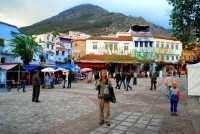
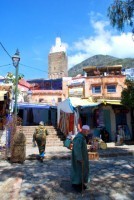

Blog post by Roderick Phillips, author of Weary Heart – a gut-wrenching tale of love and test tubes.
The post Chefchaouen, Morocco, Day 251 appeared first on Roderick Phillips.
April 14, 2014
Volubilis, Morocco, Day 259
It’s a shame that Christi continues to feel under the weather because Morocco and its cuisine was supposed to be a highlight of her Year of Wonder. She continues to drag her aching body around Morocco, though, and today it’s the Roman ruins of Volubilis. The site is 33 km north of Meknes, which means getting there will be a little complicated. In the end we take the train from Fes back to Meknes and hire a Grand Taxi (which in reality is a rather decrepit Mercedes station wagon). For 350D (about US$35) the taxi driver agrees to take us to Volubilis, wait while explore, and then bring us back to Meknes train station. The taxi driver insists we stop for lunch in the nearby town of Moulay Idriss. It’s another key tourist site he says and the price is the same either way, so we meekly agree. It’s been my experience that Arab people really do like to negotiate a specific price for a specific itinerary ahead of time. What they don’t like are changes to an itinerary – and certainly not if there is no more money forthcoming. But whatever you do, don’t pay until the tour is complete.
This is true even of the tour guide we engage at the ruins of Volubilis. Mornings is rush hour at the ruins, apparently, so tours are brief because the guide wants to cram in as much business as possible before the tourists depart for Fes or Meknes. Come in the afternoon, on the other hand, and the guide will bore the pants off you with historical minutiae. We arrive at the peak of the rush hour crush and Abdul, our guide, is frothing at the mouth. Initially, I thought this was from enthusiasm to impart his knowledge, now I think he has rabies. He rushes us from ruin to ruin, never allowing Christi a moment to take a sip from her water bottle or me to take a photo. And not only does he hold out his hand at the end of the tour demanding his 150D fee, he’s visibly displeased when we don’t give him a tip. He even asks, ‘Where’s my tip?’ to which I reply ‘Where’s our tour?’ He leaves in a huff and we return to the ruins with our trusty Lonely Planet guide-book.
In keeping with virtually every place we have visited on our Year of Wonder, Volubilis is a UNESCO World Heritage site (since 1997). A settlement has existed at Volubilis since the third century BC, but it was not until the arrival of the Roman Empire in 40AD that the town took off. Over the next two centuries major monuments including the triumphal arch, basilica, capitol, and baths were erected (which is a long time to wait for a soak in the tub). Most impressive of all, though, are the floor mosaics, including those depicting the 12 tasks of Hercules, Dionysus, a desultor athlete, and Bacchus getting frisky with new flame Ariadne. The Romans remained in control of Volubilis until 280AD when the city was abandoned to the Berbers. The city continued to be inhabited until the 18th century when Moulay Ismail the Bloodthirsty plundered the site for marble to build his palace in Meknes. Many of the remaining antiquities have been removed to museums in Rabat and even the Louvre, but Volubilis is still a great place to visit.
Five kilometers east of Volubilis is the laid-back hill town of Moulay Idriss where we stop for a late lunch. The town is named after Moulay Idriss who arrived in 789 AD from Mecca. Indeed, Moulay Idris was the great-grandson of the Prophet Mohamed and so it’s probably not surprising that it was he who introduced Islam to Morocco. Moulay Idriss also began construction on the city of Fes, work that was later completed by his son. A mausoleum containing the remains of Moulay Idriss dominates the small hill-side town, but it is not open to non-believers. The town of Moulay Idriss is also unique in having the only mosque in Morocco with a circular minaret. Now how’s that for useless trivia!
After another long day on the tourist trail we return to Fes where the ailing Christi revitalises herself at that temple to Western consumerism, McDonald’s.
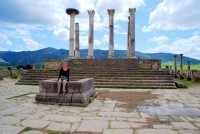
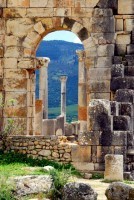
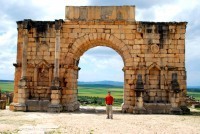
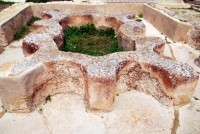
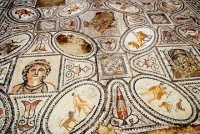
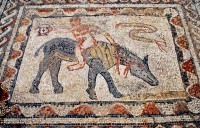
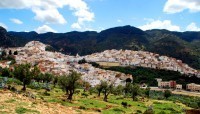


Blog post by Roderick Phillips, author of Weary Heart – a gut-wrenching tale of love and test tubes
The post Volubilis, Morocco, Day 259 appeared first on Roderick Phillips.
April 13, 2014
Meknes, Morocco, Day 258
Although Christi remains tired and poorly, she still wants to explore. And today we take the train to nearby Meknes, another Moroccan city with an ancient medina and square. Although founded in the 9th century, Meknes did not rise to prominence until the 17th century when the infamous Moulay Ismail became sultan of Morocco and chose Meknes as his capital. Ismail the Bloodthirsty was a warrior king and to intimidate his rivals he ordered that the city walls of Meknes be adorned with 10,000 heads of slain enemies. When not empire building, he also built elaborate palaces and monuments in Meknes, but what truly boggles the mind is that he is alleged to have fathered over 800 children. Which begs the question of how did he find the time and energy to be so productive (no pun intended).
Before embarking on an ambitious project to father a child or two of my own during our day trip to Meknes, Christi and I have a couple of chores to do, notably arranging onward transportation not only from Fes to the mysterious mountain town of Chefchaouen, but also from Morocco to Tunisia. At one point we had grand plans to travel overland through Algeria (which is contiguous with both Morocco and Tunisia), but Algeria is a difficult country to negotiate and in the end lack of time meant we had to change our plans. Christi is relieved to have one less adventure in the Sahara, but don’t worry folks there is still plenty of sand in our future. And here’s another bizarre fact, the cheapest way to fly to Tunis (capital of Tunisia) from Casablanca in Morocco is via Rome. Go figure!
With the chores out the way we visit Place el-Hadim via the beautifully carved Bab el-Mansour gate in the heart of the Meknes medina. Place el-Hadim is a sort of Djemaa el-fna without the atmosphere. We do however enjoy a tasty lamb tajine (me) and Harira soup (Christi) for lunch before we explore yet another medina. The Lonely Planet guide offers a walking tour and this seems the best way to see some of the major sites without resorting to the services of yet another retail-focussed tour guide. Apparently you can ask for a non-retail tour, but you have to pay the guide a lot more money! In truth the medinas are becoming a little stale now. We have visited so many in Morocco that it’s hard to find something new (like the tanneries of Fes). Added to which Meknes medina is much smaller than Marrakesh or Fes, so the 90 minutes we spend wandering around exhausts the points of interest: mosques, souqs (carpets, jewelry, leather goods, and spices), and food stalls. With time on our hands we pop into the Dar Jamai Museum, supposedly one of the best museums in the country. Not many of the exhibits have legends in English, but it’s still fun to look at the exquisite jewelry, ceramics, textiles, and carpets. And best of all we have the place virtually to ourselves.
Barely 5 hours after arriving in Meknes we return to Fes. In addition to feeling nauseous Christi is now craving McDonald’s (my god did I really get her pregnant in Meknes? We detour to a pharmacy where a pregnancy test proves to be negative – truly!). Amazingly (if the day could be any more amazing) Fes does have a McDonald’s and Christi rips into a cheeseburger and fries, which she says is de-licious.
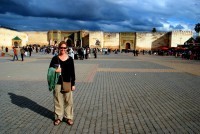
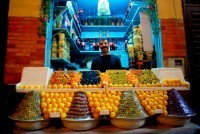
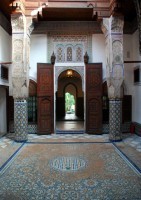


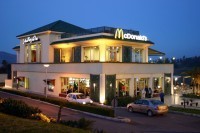
Blog post by Roderick Phillips, author of Weary Heart – a gut-wrenching tale of love and test tubes
The post Meknes, Morocco, Day 258 appeared first on Roderick Phillips.
April 12, 2014
Fes el Bali, Day 257
Christi is feeling marginally better today so Saleem, the manager of the riad in which we are staying, organizes a tour of Fes el Bali (Fes’s old medina) for us with the one-armed guide, Abdullah. Interestingly, Saleem has not insisted on increasing our room rate from the introductory figure of 500D to the higher rate of 850D that he insists our room is worth. I’m sure it’s merely a coincidence that Christi and I are his only guests currently.
We begin our exploration of Fes el Bali in the same neighborhood as our riad by visiting a date / fig market, a traditional olive oil processing center, a traditional crepe-makers, and a snail wholesaler. And trust me, that’s a whole lot of slime. Normally, Christi would be very excited by the exotic aromas wafting around us, but today the smells merely add to the feelings of nausea she’s experiencing. It’s not always fun traveling the world, but Christi struggles on bravely and without complaint.
I can vaguely follow where Abdullah is taking us and surprisingly we don’t stop at the Chouara tanneries, which I want Christi to see. He insists we will visit these later, but for the moment Abdullah seems more intent on showing us all the available retail opportunities in Fes el Bali, especially carpets. Once ensconced in the showroom our guide disappears and the owner of the store begins his charm offensive. We’re offered mint tea and snacks, while dozens of carpets are unfurled before us. I half expect to see Cleopatra pop out of one and seduce me into buying a rug. What a great fantasy. Christi is tempted to buy something even without the disarming presence of Cleopatra. Is it possible the owner slipped a drug into our mint tea that makes you want to buy a carpet? I retain enough sense to drag Christi out of the shop before negotiations can begin. Abdullah is somewhat surprised by our sudden reappearance and rushes to catch us up. ‘No more retail opportunities,’ I insist. He looks crestfallen and reluctantly takes us to the Al-Attarine medersa, which is another stunningly decorated Islamic school with beautiful carved marble, cedar, and stucco.
From the medersa we visit the mausoleum of Moulay Idriss II, where Moslems are at prayer (there are separate areas for men and women). Moulay Idriss II was the founder of Fes in the 8th century AD. We follow that up with a quick visit to the Kiraouine mosque after which Abdullah says our tour is finished. ‘But what about the tannery,’ I cry. He holds out his hand for payment and won’t move until he’s paid 150D. Only then does he reluctantly backtrack to the leather souq. He passed through a narrow alley (that would not look out of place in an Indiana Jones movie), before leading us up an obligatory set of rickety stairs. This is when Christi and I are hit by the smell and then the sight of the tannery. We stay as long as Christi can bear the smell, which isn’t long. Then out of politeness we poke around the shop for a few minutes before escaping back out onto the busy streets of Fes el Bali. Abdullah is nowhere to be found, so we head for Bab Bou Jeloud gate where Christi eats a simple Harira soup at one of the numerous restaurants to be found there. A massive downpour of hail and rain curtails our exploration in the afternoon and we return to our riad by taxi. Christi is exhausted and retires to bed while I watch K19 – The Widowmaker on satellite TV. Tonight my dreams are invaded by giants snails on flying carpets that leave slime trails across the sky. The more I think about it, the more I’m convinced there was something dodgy in that mint tea!

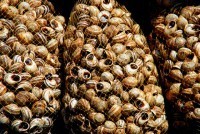
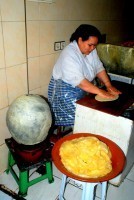

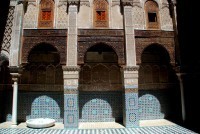
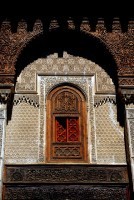
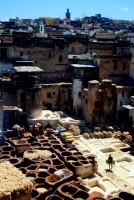

Blog post by Roderick Phillips, author of Weary Heart – a gut-wrenching tale of love and test tubes.
The post Fes el Bali, Day 257 appeared first on Roderick Phillips.
April 11, 2014
Chouara tanneries, Fes, Day 256
Christi is feeling truly awful today: she’s nauseous and has a low-grade fever. She can’t bear to eat, drink, or even get out of bed, although she stubbornly refuses any medication from her own traveling pharmacy (aside from Tylenol) or a visit to the local hospital. Which just goes to show that health care professionals really do make the worst patients. Bless her, though, she does insist I continue my exploration of Fes, allowing her to rest in peace. My plan for the day is a visit to the Chouara tanneries. These tanneries are definitely part of the tourist scene in Fes, although actually finding them (without an official guide) is tricky. In fact, negotiating Fes el Bali at all is tricky. However, I stumble accoss some information in our Lonely Planet guidebook to Morocco that should help. There are color-coordinated signposts dotted irregularly throughout the medina designed to help you find your way around, which has got to be an improvement on yesterday’s approach of basically being lost all the time.
And progress is remarkably swift. reach the Chouara tanneries in only 15 minutes with barely a wrong turn. Of course once you are in the vicinity of the tanneries, a lonesome tourist is not lonesome for long. I’m invited into a leather shop and urged to climb a rickety set of steps to a viewing platform. Indeed, there are several leather shops sitting cheek by jowl with one another and each has its own viewing platform of the tanneries below. Two things strike me immediately: one is the pungent aroma that quickly invades the back of your throat and second the space. The medina is full of tall buildings that block out the light and narrow, winding alleyways that give the place a claustrophobic feel. The tanneries are a breath of fresh air – or at least they would be if the smell was not so overpowering.
Gazing out over the Chouara tanneries is an impressive sight. From the viewing platform, the scene below resembles a series of paint pots where ant-like figures go about the arduous and unhealthy task of cleaning and preparing the animal hides (goat, camel, cow, sheep) for dyeing. It takes many days of liming, scudding, pickling, and tanning to convert the animal hide into leather which can then be dyed. These cleaned and dyed skins are then taken by the leather workers (often housed in the same location as the showrooms) to make pouffes / ottomans, handbags, slippers, and jackets. These traditional leather workers are a skilled bunch and it doesn’t take them long to produce an exquisite pair of slippers so characteristic of Morocco.
The tricky part now is to exit the shop without actually buying anything. I’m not trying to be mean – I would have gladly paid for a tour – but I have no desire to carry leather goods around Africa in my backpack. Still the owners of the shop do not relinquish their hold on we quite yet. Instead of directing me to the exit I’m escorted into an adjacent perfume shop. Normally I’d be even less likely to buy perfume than leather goods, but the shop sells argan oil body lotion and so I buy a bottle in hopes of cheering Christi up a little.
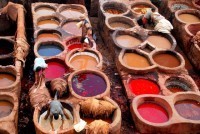
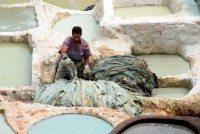
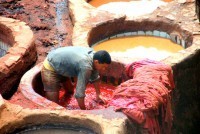
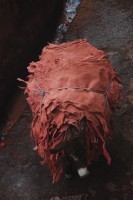

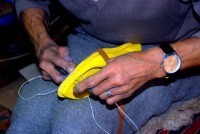
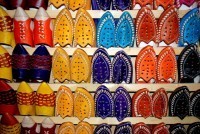
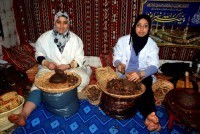
Blog post by Roderick Phillips, author of Weary Heart – a gut-wrenching tale of love and test tubes.
The post Chouara tanneries, Fes, Day 256 appeared first on Roderick Phillips.
April 10, 2014
Bab Bou Jeloud, Fes, Day 255
The riad Khouloud does at least provide a free breakfast and Christi and I take full advantage. Our plan today is to explore the medina and we ask Saleem, the riad manager, for directions through the market to the main gate, Bab Bou Jeloud. The manager shakes his head, a knowing smile creeping around his mouth. ‘Impossible,’ he says. The medina has no direction. You just have to know your way around. He does, however, point us in the right direction as we exit the riad – and gives us a business card. ‘Don’t lose it,’ he says because the taxi driver will need to call us. It’s my turn to give him a wry smile. I’m pretty good at finding my way around. Christi and I won’t need a taxi back to the riad, although in truth I’m not sure where the riad is or where the medina is or how to get to Bab Bou Jeloud, so perhaps I’m being unduly optimistic.
I am being unduly optimistic. Christi and I lose our way within 5 minutes of entering Fes el Bali (this is the oldest part of Fes). We are at the extreme eastern edge of Fes el Bali and we want to walk through the medina to the western entrance at Bab Bou Jeloud. The eastern section of the medina is clearly more authentic as locals go about their daily business of buying provisions in the market. We are the only tourists in this part of town and we get some strange looks. It’s time to embrace being lost and uncomfortable. We try in our limited French (our Arabic is non-existent) to ask for directions to Bab Bou Jeloud. ‘Bab Bou Jeloud?’ they cry. Eyebrows are raised, and wild hand gestures point into the far distance, which makes me wonder if we are even in the right city. We plod along past dozens of narrow alleys, never knowing which turn will take us closer to Bab Bou Jeloud. We eventually escape the claustrophobic clutches of the medina, but our passage is blocked by a fast flowing river, the Bou Khareb, where men appear to be risking life and limb to wash animal skins.
It takes more than an hour of wrong turns and repeated requests for directions before we finally reach the western gate at Bab Bou Jeloud. After the wide-open spaces of Djemaa el-Fna the row of restaurants stretching out from the Bab Bou Jeloud arch is a little underwhelming. Still we are hungry after our exertions and order a late lunch of lamb tajine from a street vendor.
The Fez medina is collected into different areas for different purposes: produce, leather work, slippers, ironmongery, ceramics, silks, jewelry, and carpets to name but a few. The stall holders appear to at least tolerate tourist cameras and are not that aggressive in pursuing a sale. This makes walking through the medina a wonderful experience. I think it’s fair to say Christi and I embraced being lost and uncomfortable, although the prospect of trying to find our way back to our riad is impossible – mostly because I have no idea where our riad is located. Realistically our only choice is to use a taxi, although I allow myself a hint of a smile when our driver has to call Saleem, the manager of riad Khouloud, for directions.
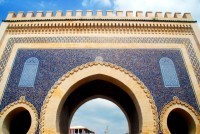

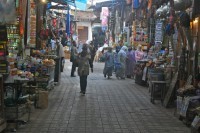
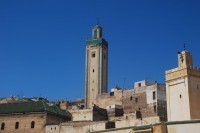
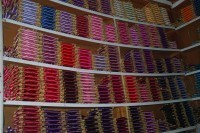
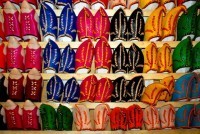
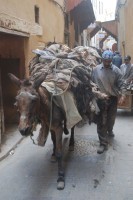

Blog post bt Roderick Phillips, author of Weary Heart – a gut-wrenching tale of love and test tubes.
The post Bab Bou Jeloud, Fes, Day 255 appeared first on Roderick Phillips.
April 9, 2014
Riad Khouloud, Fes, Day 254
It’s another travel day and this time Christi and I are letting the train take the strain. We leave Marrakesh for the jewel of Moroccan tourism, the mysterious city of Fes located in the shadow of the Atlas Mountains in north central Morocco. And we have first-class window seats. Public transport does not get much better than this. Second class rail tickets are about the same as the bus, but at 295 Dirham first class is 100D more. Still we’re worth it, and it is an 8-hour journey. For once we do not have onward accommodation booked, but we’re tempted by the idea of staying in a traditional Moroccan house or riad. Typically these houses have an interior garden or courtyard, which stems from Islamic beliefs around maintaining privacy for women. In fact, the word riad comes from the Arabian term for garden, which is ‘ryad’. Our Lonely Planet guidebook says that a scam of sorts exists aboard trains going to Fes where friendly locals begin a conversation with innocent tourists that end with the tourist staying in the riad recommended by the local!
The start of another journey comes with the usual frisson of excitement and expectation. Initially, our route is almost due north; we’re heading for the Atlantic coast at Casablanca. The scenery is pastoral with livestock grazing by the train tracks and meadows replete with beautiful wild flowers. Once we reach Casablanca we follow a coastal route to Rabat, capital of Morocco. The train does have a food service – a simple arthritic-sounding food trolley (which resembles something out of the Hogwarts Express, although there are no pumpkin pasties or chocolate frogs) pushed by an equally dilapidated man puts in a regular appearance and we indulge repeatedly. Beyond Rabat, we head inland again through mountainous terrain that ultimately brings us into Fes. Somewhat disappointingly the other passengers do not strike up a conversation with us – until the last leg of the journey between Meknes and Fes. Finally the scam unfolds (I was beginning to think we were not scam-worthy). His name is Jumilla and he really is a friendly chap. He casually recommends the Riad Khouloud, which is located on the fringe of the massive central medina. By sheer luck he even has a brochure and their business card, having stayed there himself recently. As scams go this is quite painless so far and when he offers to make a reservation for us. He whips out his mobile phone at this point and I have put my hand over my mouth to hide my smile. Jumilla even persuades the riad owner to meet us at Fes train station and provide a free transfer. Life doesn’t get any easier than this. Let’s hope the reality matches the hype.
Introductions are effected outside Fes train station and Jumilla then fades into the background. We are whisked off to the riad Khouloud, which is located somewhere in Fes on a non-descript narrow street. Much like the home of Mohamed (our driver from Marrakesh), the exterior of the riad gives no hint of the wonders within. Arab / Berber life really does go on behind closed doors. And the life in this riad is pretty luxurious. We are encouraged to sit in the courtyard and tea swiftly appears. The courtyard is beautifully decorated in classical Moroccan style. There are stunning mosaics, delightful geometric patterns, and gorgeous wood paneling detail. The sofas and cushions have an Arabian Nights feel to them. They are bright, colorful and comfortable. The mosaic floors are covered in plus carpets and animal skin rugs.
After settling into our surroundings, the room rate negotiations begin, which is a surprise to us because the friendly Jumilla assured us the price was 500D per night (about US$65) – the absolute most we are willing to pay (our daily budget remains US$100 remember). Saleem the manager insists their best price is 850D, which is our cue to leave (although quite where we are and quite where we are going are unknown). We begin to strap on our backpacks (a heinous chore), when Saleem ‘blinks’. Clearly Saleem and Jumilla believe Christi and I to be richer than we are! We agree to stay for 2 nights at 500D per night, but the search is on for cheaper accommodation and something nearer to the center of the medina.
Our room is decorated in a similar style to the courtyard and features a 4-poster style bed replete with drapes of deepest red and a red velvet upholstered headboard. Everything is elaborate, yet there are also the modern touches such as satellite TV and air-conditioning. The icing on the cake is the bathroom (adorned with beautiful blue tiles) which features a Western-style toilet and a bath tub. This is luxury beyond our wildest dreams. We can’t afford the fixed price 5-course dinner (230D), though, and are forced to scavenge the trash cans out on the street (OK that’s a slight exaggeration as we eat off food carts) but Christi’s main desire is a long soak in a hot bath. Now that is de-licious.
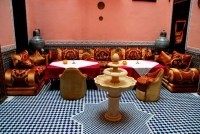
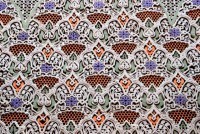
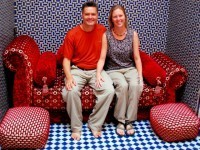
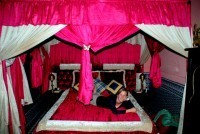
Blog post by Roderick Phillips, author of Weary Heart - a gut-wrenching tale of love and test tubes.
The post Riad Khouloud, Fes, Day 254 appeared first on Roderick Phillips.
April 8, 2014
The Draa valley, Morocco, Day 253
Once again Christi and I want to make changes to the program, although this time we want to add something rather than take it out. Having completed the original itinerary in a rather rushed manner, the only thing left to do today is a relatively easy drive back to Marrakesh. But since we’ve hired the car and driver for three full days, we want to utilize that extra time see as much of the area as possible. Mohamed is less enthusiastic about this suggestion and pulls out his mobile phone to call Mohamed the tour operator. Our original itinerary included a visit to the Draa valley, but we only explored the very northern tip. Christi and I decide that with the whole day ahead of us it should be possible to drive the entire length of the Draa valley, finishing in Zagora. The Mohammed’s confer; it will cost an extra 150D (about US$20) for gasoline – so be it. Suddenly, the easy day Mohammed our driver had been expecting will now be much longer.
One point that is not made clear in our Lonely Planet guide-book is that although the distance to Zagora is relatively short, the time it takes to get there is complicated by poor roads, crazy traffic, and mountains – this time Jebel Sahro. Although not as extensive as the High Atlas they are nonetheless very impressive sharing as they do similar geologic features such as dramatic fault lines and deep canyons. Apparently, the Jebel Sahro are also home to all manner of geckos and chameleons – at least according to the Arab wrangler who throws them on me at a view-point and for once I play along.
The Draa valley comes a something of a surprise after the austere mountains. The Life-giving Draa River supports endless lush green palmeries, which in turn harbor Berber villages and their ubiquitous vegetable gardens, against a backdrop of steep mountains. Sadly the clouds of yesterday remain today, dulling the scenery around us. We reach Zagora in time for a late lunch (after first photographing ourselves beside the new ‘Tomboctou 52 jours’ sign). Thereafter it’s a long 6-hour 350 km drive back to Marrakesh. We basically follow the same route in reverse: up the Draa valley, over the Jebel Sarhro and the High Atlas Mountains negotiating the long, slow crawl into the city. In addition we stop several times – mostly because Mohamed is exhausted and occasionally to allow me to photograph the magical scenery. We arrive back at the hotel CTM by 8:30pm. We thank Mohamed for the wonderful excursion, give him a generous tip, and then enjoy a final dinner at one of the temporary restaurants in Djemaa el-Fna. Even though we’ve largely been sat on our butts for the last three days we are so exhausted we sleep like babies.

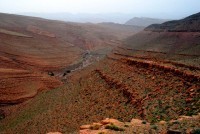
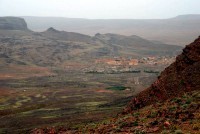
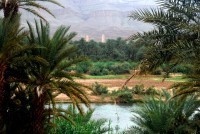

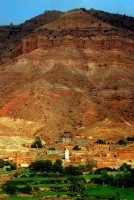
Blog post by Roderick Phillips, author of Weary Heart – a gut-wrenching tale of love and test tubes.
The post The Draa valley, Morocco, Day 253 appeared first on Roderick Phillips.
April 7, 2014
Ait Benhaddou, Morocco, Day 252
Despite the fact Christi and I agreed our itinerary with Hilali tours before we set out, for some reason we are scheduled to do a long drive to visit the oasis town of Arfoud (near the border with Algeria) today, before looping back to the Draa valley and improbably reaching Ait Benhaddou before sunset. This is clearly impractical and our driver, Mohamed, quickly agrees (no doubt because it is less work for him). Our overnight stay in the hotel Tamlalte was very peaceful, possibly because we were the only guests. This was a bit disconcerting at dinner last night because we were the only people in the restaurant as well – but at least the service was good.
We retrace our route of yesterday back through the Dades Gorge to the main town in the area, Boumalne du Dades. From there we head east to Tinehir and eventually north to another famous gorge (at least according to the Lonely Planet). And much like Dades gorge, Todra Gorge is a heavily populated area: Berber villages are nestled amid the palmeries and beneath pink granite cliffs that rise vertically, almost blocking out the light at one point as the sides of the gorge appear to converge. Unfortunately, the gorge is a building site here, which makes the whole experience rather disappointing. Apparently hiking in the mountains around the gorge is supposedly quite wonderful, but we do not have the time to do that.
Mohamed retraces our path back through Boumalne du Dades yet again and surprises us by stopping at a home on a quiet street in the town of El-kelaa M’Gouna (or Kalaat M’Gouna). Apparently its his family home and we’re invited in for lunch by his mother. The exterior of the house is quite simple and plain, but this does not prepare us for the beauty within. The kitchen would not look out of place in any fancy mansion in Beverly Hills (double sink, marble counter tops, designer cabinets), while the house (also much larger than it appeared from the outside) has several ornately decorated reception rooms. In one of these rooms there is a long wrap around sofa and plush carpet in a matching royal blue floral design. The blue is offset by walls splashed with pink paint and glitter, while the high ceilings are replete with ornate moldings and geometric patterns. It’s all quite amazing. And it is in this room that we are served tea, then fruit is brought in, and finally tajine (naturally). The mother appears to like us because, according to Mohamed at least, we have an open invitation to return. For some odd reason we are also given traditional Moroccan clothing to try on, which provokes much laughter from our hosts.
Finally reach Ait Benhaddou and our hotel for the night La Rose du Sable at 4 pm. Amazingly, despite being in the middle of the desert, there is a glittering swimming pool on site. Sadly we will have no time to enjoy the facilities. Indeed we have to dash off to Ait Benhaddou’s Kasbah (fortress) to explore before the sun sets. The Kasbah is located on the slopes of a hill facing the river Ounila. Beyond the river is a palmerie and beyond that the unforgiving Sahara. This Kasbah has provided the backdrop for many Hollywood blockbusters, including Lawrence of Arabia and Gladiator. And for this reason it is a major stop for all tour buses. This is not good for photography, but fortunately I possess the most important trait in a photographer: patience. Conversely, tours are all about speed and the tourists are rushed through the fortress lickety-split. As the tour groups finally leave and sun sinks low in the sky Ait Benhaddou is bathed in a beautiful warm light that almost brings the place back to life. Snap!



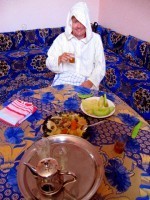
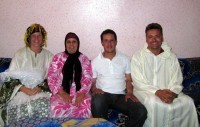
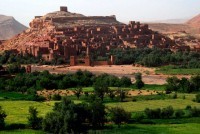
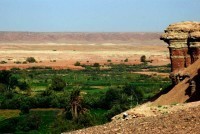
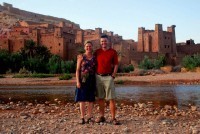
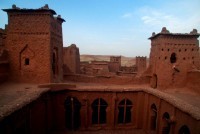
Blog post by Roderick Phillips, author of Weary Heart – a gut-wrenching tale of love and test tubes.
The post Ait Benhaddou, Morocco, Day 252 appeared first on Roderick Phillips.
April 6, 2014
Dades Gorge, Morocco, Day 251
Time to say goodbye to Marrakesh – at least for a few days. Mohamed, the manager of Hilali tours introduces Christi and I to Mohamed our driver (26, single, Berber). Day 1 of our brief visit to Southwest Morocco is to drive over the High Atlas Mountains, visit the Valley of roses, and explore Dades Gorge. Mohamed, our driver, will show up the good photo spots, avoid the tourist traps, and stop whenever we ask him. This sounds perfect. The reality is a little more frustrating, however. Mohamed may agree with everything we say, but I don’t think he actually understands what we’re saying. Apparently the phrase ‘English-speaking driver’ is open to interpretation. Mohamed also drives rather quickly so by the time I decide to stop, he is already some distance further on. And while the route up and over the High Atlas via the Tichka Pass is undeniably spectacular, it is also narrow and winding so that parking at a scenic vista is not always possible. Clearly Mohamed is not going to point out the stellar viewpoints. His main goal appears to be to complete the itinerary as described as quickly as possible, rather than show us his country. From our perspective the itinerary is just a guide not a definitive road map.
The High Atlas Mountains are a dramatic combination of fault lines and upheavals that make for an impressive landscape. The mountain sides are steep – a landslide always look imminent – with occasional parcels of cultivated farm land, lush and green against the mountain backdrop of gold, reds, and browns. Dotted among the hills are an abundance of Berber villages clinging tenaciously to the rock faces, while the Berbers themselves are busy growing crops, gathering wild plants, and herding goats and sheep over some seriously steep and rocky terrain. The villages themselves tend to be mud brick structures, any of which have been abandoned leaving behind picturesque ruins. Mosques are commonly salmon pink, standing proud against dull brown backdrops. Despite the harsh conditions, the mountains are a hive of activity and those not engaged in traditional industries ensure there is an inexhaustible supply of tourist trinkets. And there are plenty of tourists to go around: many appear to be on group tours, although there are several French camper van convoys en route. The tourists share the road with pedestrians, herds of goats and sheep, donkey and carts as well as large tankers and trucks bringing vital supplies to the region. This twisting, winding two-lane road through the mountains is the main artery for all communications with Southwest Morocco. It’s a stunning 4-hour drive (through mountains decorated in wild spring flowers) to a lunch stop in the delightfully named Ouarzazate (pronounced ‘Wazazat’). We eat yet more tajine, but its wonderful stuff from an authentic local restaurant not some tourist affair (thank you Mohamed).
Finally reach the Dades gorge near sunset. And much to my surprise it is not the pristine, isolated trekking mecca I had imagined, but rather a valley heavily populated with Berber villages. True, the villages, palmeries, the Dades River and granite rock faces are picturesque, but the whole effect is so different from my Lonely Planet- inspired image. It’s really not that different to any other Berber valley, although the ‘monkey pad’ rock formations are fascinating. We eventually persuade a reluctant Mohamed to go beyond the regulation stop at our hotel (the hotel Tamlalte) to explore more of the gorge, which ends in a dramatic twisting, winding road out of the steep-sided valley. And at sunset, the mountainside turns golden brown, which is a magnificent spectacle to end the first day of our tour.
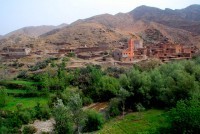
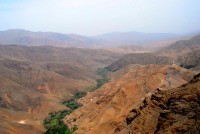
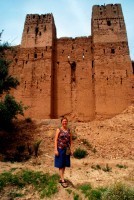
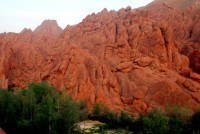


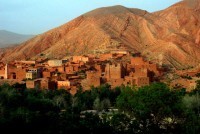
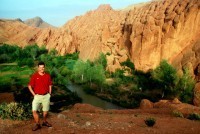


Blog post by Roderick Phillips, author of Weary Heart – a gut-wrenching tale of love and test tubes
The post Dades Gorge, Morocco, Day 251 appeared first on Roderick Phillips.

